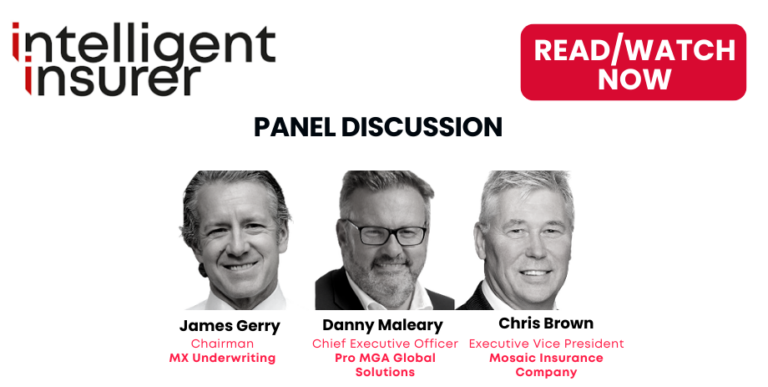A lot of risk capital providers want to move into the managing general agent (MGA) space but are not sure of the best way to move forward. These providers can also be nervous about backing the wrong MGA or are looking for a particular type of MGA. So how can MGAs persuade these providers and ensure it’s the right fit for both parties?
Who are these tentative capital providers, and why are they nervous? Follow the link below to read or watch the Intelligent Insurer panel discussion, titled “MGAs: attracting tentative risk capital providers into the market”, with James Gerry, chairman of MX Underwriting; Danny Maleary, chief executive officer of Pro MGA Global Solutions; and Chris Brown, executive vice president at Mosaic Insurance Company.

Preview clips below. Watch the full interview here
MGAs: attracting tentative risk capital providers into the market
https://www.intelligentinsurer.com/article/mgas-solving-the-conundrum-of-tentative-capital-providers
https://www.intelligentinsurer.com/article/mgas-finding-and-engaging-unknown-capital-providers
Published with the kind permission of Intelligent Insurer

Name: Danny Maleary
Job title: CEO, Pro MGA Global Solutions
To speak to the Pro Global team please feel free to reach out to us at:

To contact our PR team directly please use the link below

Over the last few years, a number of insurers with Employers’ Liability (EL) insurance books of business have sought exit solutions to manage legacy exposures. Mike Mackenzie, Head of Speciality Claims at Pro Insurance Solutions, discusses some of the approaches that have been taken and his experiences with UK EL portfolio transfers to make these a success.
Employers’ liability insurance is a legal requirement for the majority of businesses that employ staff, no matter what size. The policy can cover the cost of compensation should an employee incur an injury or illness as a result of work they are carrying out on behalf of a business. As well as covering the cost of compensation, the policy can also cover the cost of the claim and legal expenses incurred by the business while defending the case.
By way of context, estimates suggest that gross written premiums in the UK employers’ liability market were just over £1 billion in 2020. The sector is more closely aligned to developments in the UK economy than many other insurance lines – and the COVID-19 pandemic has had a significant impact given that the economy was virtually at a standstill for much of 2020 and well into 2021.
With unemployment in the UK currently standing at just over 4% and the furlough scheme having come to an end on 30 September 2021, the EL market has undoubtedly been directly impacted as it is reliant on the number of businesses and employees.
Long-tail liabilities
If we look back at the market historically, EL policies have given rise to a number of long-tailed liabilities – for example, claims from diseases following workplace exposure to asbestos containing materials. While there have been high volumes of claims to date, most long tail claims are now in decline (including asbestos-related diseases).
Notwithstanding, the fact that these claims are in decline, insurers and those who have acquired legacy portfolios can expect to be paying claims for years to come. The reason for this is these types of claims are often covered by policies that were in force at the time the exposure took place – and with asbestos claims as an example, these could be policies that were issued many years ago.
Insurers with these sorts of legacy exposures need to hold significant reserves and capital to cover the potential future costs of settling these claims at some time in the future and managing these sorts of books of business can be a time-consuming and costly exercise. So what can insurers do to resolve these issues?
Managing legacy exposures
Over the last few years, a number of large household name insurers with EL books of business have sought exit solutions. One such solution is a mechanism called a loss portfolio transfer – or reinsurance of the liabilities to a third party. This takes away some of the uncertainty from an insurer’s balance sheet but it does not get rid of the problem completely because the insurer remains on risk and should the reinsurance prove to be inadequate or the reinsurer goes out of business, the liabilities revert to the insurer.
Another option is a legal transfer of the book of business via a court-sanctioned process called a Part VII transfer – known as such because it relates to Part VII of the Financial and Services Markets Act which is the legislation applicable to such transfers. There are similar arrangements in many other European countries but in some instances, these only require the approval of the regulator rather than a court.
Measures of success
In the early days of UK EL transactions, concerns would always be related to those areas that are most important, namely people and data. The sellers of these books had arrived at the decision to sell for a number of reasons and often over long periods of time before finally making the decision to sell. Often, we encountered years of uncertainty for the teams within these companies as well as a lack of investment in IT, multiple-source systems, inadequate and often corrupt data.
When clients have made significant investments and fully expect value to be realised, the need for us to ensure data transfer and a team of fully motivated professionals are in place is always something that needs focus and hard work. Until that is in place, it is a concern.
People and Data are key
From a Pro perspective, we have provided both claims handling services, technical insight as well as operational due diligence and strategic advice for a number of such transactions. With portfolios such as these, there is of course a very important pre-bind process of understanding reserving, the philosophy and adequacy – which relies on significant experience across a range of claim types and we see a number of clients who have seemingly different views on these issues.
Putting pricing and reserve adequacy to one side, the key is to understand how the book can be managed operationally. The two key elements to that are data and people: pre-bind, we would be looking to understand the quality and depth of both, creating plans for integration, data migration, data cleansing and building out a target operating model, with the right processes and people in place.
Very often, these are client-specific: the claims philosophies and reserving can vary, reporting requirements dictate data needs and claims philosophies dictate the types of people needed. There is much that is common across all clients – clear regulatory compliance, treating customers fairly, the Employers’ Liability Tracing Office requirements, to mention but a few. Pre-bind, we are not only understanding the target portfolio and operations, we are working with the acquirer to define their ongoing needs, identifying areas of value that need to be protected and subsequently operationalised to ensure success.
Assuming control of a portfolio from a risk carrier continues to evolve post-bind as you continue to transform processes, develop strategies, work with the transferred team and integrate into existing teams. Adopting best practice and challenging the status quo are also vital – as is investment in data to deliver strategies of value, to understand the underlying performance of the team and the book itself.
Working with an experienced partner is key
Transactions continue to be active in the UK EL space and whatever the approach taken, these are often highly complex – with robust pre and post-bind due diligence, expertise and ongoing support of paramount importance.
Working with a trusted and experienced partner and adviser like Pro can help companies and their management teams navigate successfully through the challenges that these deals often present.

Name: Michael Mackenzie
Job title: Head of Speciality Claims
To speak to the Pro Global team please feel free to reach out to us at:

To contact our PR team directly please use the link below
La gestión de siniestros se vuelve cada vez más compleja a medida que aumentan los riesgos que toman las aseguradoras y la cantidad de pólizas que emiten. No es posible para una empresa contratar internamente a todos los especialistas que hacen falta para hacerlo bien. Por eso, Pro es un aliado estratégico. Tenemos la experiencia para administrar de manera simple y ágil las operaciones de siniestros.
Alcanzamos la eficiencia gracias a nuestra economía de escala y logramos para nuestros clientes una mejor planificación financiera, mejores flujos de caja y un balance más saludable.
Nuestras especializaciones:
Auditoría de las funciones delegadas de siniestros.
SOLUCIONES RUN-OFF
Pro ayuda a las aseguradoras a ser más proactivas en la administración de run-off. Combinando una sólida experiencia en la gestión de siniestros con tecnología desarrollada específicamente para esta gestión, en Pro tenemos un enfoque exitoso para la gestión de carteras que le permite a nuestros clientes volver a concentrarse en el negocio real.
Podemos ayudarlo con:
Asesoramiento estratégico sobre carteras; tratar con due diligence; gestión de siniestros de front-end hacia adentro y soporte de back-office escalable; soluciones de datos, transformación operativa, análisis de reservas y revisión actuarial, reemplazo de corredores; reaseguro de run-off; informes de cumplimiento normativo; plataforma ProTucket US Insurance Business Transfer.
ART’S
Somos líderes en el mercado de siniestros complejos de EL o por discapacidad y podemos asesorar a nuestros clientes sobre las mejores estrategias para sus carteras. Ayudamos a las ART a optimizar sus procesos, reducir la fricción con sus asegurados y bajar el costo por caso. Nos enfocamos en lograr los mejores resultados, tratando a sus asegurados y reclamantes de la manera más justa.
Podemos ayudarlo con:
Agilizar los procesos de siniestros; reclamos complejos de responsabilidad e incapacidad de los empleadores; reserva de siniestros; reducir los costos legales; tercerización de reclamos de responsabilidad patronal (EL) o plataformas tecnológicas; ayuda legal/técnica con casos desafiantes.
Más información aquí: https://pro-global.com/what-we-do/areas-of-functional-expertise/claims-management/el-pl-claims/
ADMINISTRACIÓN DE SINIESTROS
Somos expertos en la gestión de reclamos por siniestros. Ayudamos a nuestros clientes a simplificar sus procedimientos, a reducir los costos operativos y a brindar una excelente experiencia a sus clientes. Además, podemos proporcionar recursos extras temporales para cubrir los períodos pico de actividad de siniestros. Nuestros expertos se alinean con la cultura de cada compañía y trabajan de manera proactiva, liberando recursos internos para que se concentren en las actividades específicas.
Podemos ayudarlo con:
Negociaciones con asegurados y cedentes; asesoramiento independiente sobre litigios y arbitraje; análisis de reservas y revisión de cartera; soporte técnico (ej. clasificación e indexación); evaluación, crítica y negociación de recompras y conmutaciones de pólizas.
PLATAFORMA DE SINIESTROS COMPLEJOS
Pelican es una plataforma para la tramitación digital de siniestros de extremo a extremo creada específicamente para responsabilidad compleja. Capaz de absorber datos de sistemas heredados (incluso los basados en papel y los de pantalla verde), Pelican vincula de manera inteligente múltiples pólizas de múltiples aseguradoras contra siniestros individuales. La plataforma automatiza y consolida los procesos manuales, lo que aumenta la eficiencia del administrador de siniestros, mejora la experiencia del reclamante y reduce los costos operativos, todo al mismo tiempo.
Nuestra plataforma Pelican es un sistema simple que se basa en siniestros de exposición, no en pólizas. Incluye la lógica empresarial subyacente para los siniestros basadas en la exposición, la eliminación de duplicaciones y MI flexible.
Más información por correo electrónico a: pro-claims@pro-global.com
AUDITORÍAS DE SINIESTROS
Brindamos revisiones y auditorías de siniestros de terceros. Realizamos auditorías tanto reglamentarias como técnicas en múltiples territorios e incluso con reclamos en varios idiomas.
Podemos ayudarlo con:
Auditorías delegadas de siniestros; revisiones de siniestros; revisiones de expedientes de siniestros de Lloyd’s; auditorías de pérdidas o fugas de siniestros; reseña de reservas; auditorías de siniestros de terceros (TPA y DCA); reclamos de due diligence.
Más información aquí: https://pro-global.com/audit-in-depth/
SOLUCIONES ESPECÍFICAS PARA CADA REGIÓN
Sabemos que diferentes mercados requieren diferentes especialidades. Tenemos 28 años de experiencia adaptada a múltiples mercados e idiomas.
Administración de pólizas con soluciones especializadas para cada región:
Soluciones de reclamos por discapacidad (Alemania)

To contact our PR team directly please use the link below
Cuando una empresa tiene un gran volumen de transacciones, la cobranza es uno de los mayores desafíos a la hora de mantener un sano flujo del dinero y un registro ordenado de las operaciones. Las áreas a cargo se esfuerzan por conciliar el efectivo y asignar cada una de las transacciones salientes y entrantes.
LA PROBLEMÁTICA. Sin embargo, muchas veces el dinero se mueve o deja de moverse sin que quede debidamente registrado, sin que los sistemas lo noten y sin que los procesos lo rastreen. Así, el dinero “fuera del radar” (que está pero no sabemos de dónde vino o que falta y no sabemos dónde quedó) se acumula y, en muchos casos, alcanza cifras significativas que terminan afectando las operaciones comerciales y, en última instancia, la rentabilidad de las empresas.
En el mercado de seguros esto pasa con frecuencia en el flujo de dinero que se mueve entre compañías de seguros, brókers y reaseguradores. Desde una perspectiva de contabilidad técnica, hay muchas transacciones que procesar y mucho dinero para conciliar. En el volumen y la velocidad de la operación diaria, sucede que siempre una porción de ese dinero queda fuera de registro.
Si se analiza la cartera de una compañía se seguros se detectará que se les termina debiendo, entre otras cosas, ajustes de primas de contratos de exceso de pérdida, participación en las utilidades en contratos proporcionales o siniestros. Los reaseguradores, por su parte, terminan perdiendo prima. A los brokers, además, se les debe su corretaje.
LAS CAUSAS. Muchas veces esto sucede simplemente por una desprolijidad en los procesos (el excesivo tiempo que transcurre entre una liquidación y el procesamiento real de dicha liquidación, por ejemplo) o una desinteligencia entre áreas, pero el origen puede estar en una diversidad de causas, desde la falta de recursos humanos abocados al seguimiento de estos movimientos hasta la realidad propia del mercado de seguros que complejiza ese seguimiento (brokers que se fusionan, contratos que migran de un reasegurador a otro, etc.). Estas situaciones afectan a las compañías de seguros independientemente de su tamaño y del mercado en el que operen.
Los saldos sin cobrar no solo escalan en monto, sino también en tiempo y partes involucradas. Desde Pro, hemos colaborado con compañías que registraban más de 200 clientes deudores con saldos vencidos por más de un año. Ignorar esta problemática puede dañar el negocio de forma radical o, al menos, deteriorarlo. En Pro tenemos una solución definitiva para trabajar con compañías de seguros, brokers y reaseguradores.
LA SOLUCIÓN DE PRO. Tercerizar esta tarea en nuestro equipo de expertos ahorra tiempo, recursos y, en definitiva, mucho dinero a las empresas del mercado de seguros. Pro ofrece este servicio a nivel mundial y ahora, desde Argentina, estamos haciendo foco en asistir en este proceso a compañías de seguros del mercado argentino y de la región LatAm.
Nuestra especialización incluye:
A partir del requerimiento de un cliente, con la información inicial y básica, podemos desentrañar muchos años de datos procesados incorrectamente o no procesados. Nuestro equipo trabaja con una gran cantidad de sistemas y procesos diferentes para resolver las inconsistencias. La mayor parte del proyecto se enfoca en eliminar los retrasos. Esta tarea se realiza a la medida de cada cliente; no hay una solución única. En cada proyecto ponemos a disposición nuestro equipo, nuestra experiencia y pericia para dar una respuesta apropiada a la altura de la necesidad. Trabajamos a resultado, lo que garantiza esfuerzo, dedicación plena y compromiso con el objetivo.
Es una labor conjunta entre nuestro equipo de trabajo y nuestro cliente. Trabajamos sobre sus deudores con un ida y vuelta permanente. Preparamos reportes periódicos a fin de mantener informado a nuestro cliente de los avances logrados. Incluso se puede establecer una operación especial de Pro in house, en la que nuestros expertos se instalan en las oficinas del cliente para habilitar el acceso a la información necesaria y acelerar el proceso.
Al final del camino se habrán cobrado los saldos pendientes y se habrán registrado debidamente aquellos saldos incobrables. Los procesos actualizados y mejorados por Pro durante el proyecto, luego podrán seguir siendo administrados por el equipo dedicado de Pro, para hacer sostenible en el tiempo el orden en la cobranza y mantenerla al día.
Invitamos a los interesados a ponerse en contacto con nosotros para más detalles de este servicio.
CONTACTO
María Florencia Villalva
Insurance Services Manager
maria.villalva@pro-global.com
+54 9 11 3181 7649

To contact our PR team directly please use the link below

Claims costs in the complex legacy and live market are rising. Michael Mackenzie, Head of Speciality Claims at Pro Global, examines the factors that are driving this, and what insurers can do to get proactive about claims management at a time when it matters more than ever.
The early bird catches the worm, or so the saying goes, and when it comes to claims management across an insurance business, identifying and getting to grips with the issues early on can make all the difference in preventing costs from escalating.
Several factors are combining to increase the cost of claims across the market, not least the fact that inflation is currently expected to rise to an historic 11% by the end of 2022. This is driven by disruption to global supply chains and raw material distribution, which themselves are being influenced by ongoing global economic dynamics stemming from Brexit, the war in Ukraine and the impacts of the global pandemic.
The risk landscape is also changing, with increasing business insolvencies, redundancies, more litigation across industries, and increasing levels of cybercrime and the evolving threat of other criminality impacting businesses.
Long-tail legacy impacts
So, it is no surprise to many that the current costs of insurance claims across classes are projected to continue to grow in the coming months.
The high inflation environment and other current macroeconomic dynamics are increasing pressure on claims paid against historic policies such as employers’ liability and professional liability insurance. This is particularly true in respect of those claims which give rise to a range of heads of loss which are impacted by inflation, such as asbestos-related claims and other claims relating life limiting conditions, or conditions that give rise to ongoing care requirements and expenses. Additionally, the costs of business also increase, whether that be in respect of the costs of insurances or salary costs.
This in turn will put pressure on legacy portfolio owners to revisit their reserves and to proactively manage any outstanding claims against their book, and analyse accurately the potential for future claims which will impact its value.
Reserve releases
We anticipate an increase in interest in runoff transfers as a result, together with strong demand for support with claims management across legacy and runoff books. Re/insurers we speak to are interested in the solutions available for automating and consolidating manual processes when it comes to proactive management of legacy and runoff claims, and in particular accurate reserving against these books.
One of the biggest challenges can be extracting the data that is required from across the different systems it is stored on – some of which can be very old and out-of-date technology, as well as paper files.
Capable of absorbing data from legacy systems, paper-based and green screen systems, Pro’s Pelican technology intelligently links multiple policies from multiple insurers against individual claims and drives automation across a range of areas, such as excess/limits of indemnity calculations and controls, reinsurance calculations and workflow.
Pelican’s ability to automate and consolidate manual processes has been instrumental in ensuring smooth claims processing for our clients looking to make portfolio transfers or release redundant reserves.
Single (end-to-end) platform
Pelican is an end-to-end digital claims platform built specifically for the field of complex liability and legacy claims. It not only frees up the human experts working on the book of business – increasing claims handler utilization and efficiency, and reducing operational costs, but also provides a single platform to link in the various actors in any claim process.
Linking together re/insurers, clients, Pro’s team of SME’s and specialist lawyers, in an integrated platform, Pelican provides a single version of the truth and reduces unnecessary duplication in effort and process.
Critically for the current environment, Pelican is exposure claims-based, not policy-based. It includes underlying business logic for exposure-driven claims, automating controls around policy trigger and apportionment calculations based on the current legal framework by jurisdiction.
A call to action for the market
In a market where claims have a long-tail and portfolios change hands across a myriad of technology systems, these increasing costs bring into renewed focus the need to ensure claims are managed efficiently and effectively, so as to mitigate any costs inflation, whether that be in respect of indemnity or operational costs. Increasingly, these challenges are best answered through technology enablers.
As we enter this new era of global economic and political instability, re/insurers are under pressure to look forward as well as backward at the same time in order to get a proper handle on the value of their legacy and run-off books.
Those that are proactive in getting the most accurate oversight of how claims trends are developing and applying this to their own exposure management will ultimately emerge with much stronger businesses. On that basis, enhancement of technology enabled data analytics is also a key area that businesses need to address.
Contact Michael Mackenzie to find out more about how our pioneering Pelican technology can help you get a real-time handle on claims exposure.


Name: Michael Mackenzie
Job title: Head of Speciality Claims
To speak to the Pro Global team please feel free to reach out to us at:

To contact our PR team directly please use the link below

It seems that algorithmic underwriting (AU) is taking the insurance industry by storm; but while mainstream products such as house and car insurance are seeing AU being put to good use, specialty insurance is relatively new to the game. Part of the reason is down to data.
As a form of computerised automated decision-making, AU relies on data to follow a set of instructions, the most basic of which is “if X happens, carry out this action; if Y happens, carry out that action”. Unlike artificial intelligence (AI) – which can adapt instructions depending on the data or results of a sequence – AU doesn’t have this level of machine learning, so if you put unusable data into the system, your results will be unusable too.
To enable AU to work successfully, therefore, insurers need data that is cleansed and correctly formatted. They also need the right infrastructure, such as cloud-based services, plus the right underwriting knowledge and technological know-how, points of which have been highlighted by a leading Insurtech report.2
The importance of ecosystems
The first step to deliver suitable data for AU is data cleansing and standardisation, a process which can be both time-consuming and prone to errors. This is especially true for specialty lines of insurance and risk analysis, where data cleansing can involve multiple manual tasks, such as geocoding risks, mapping columns and data conversion to feed downstream systems. Not only is this process slow, but it has to be carried out for individual clients and MGAs on an annual / monthly basis.
For insurers to harness the true benefits of AU, they need system(s) that can automate these tasks and make data machine-usable, from automating geocoding and providing audit trails, to identifying new lines of insurance and even simply storing information.[1] Implementing such processes tends to work best when done in tandem with other systems and technologies, a feat which can be achieved through strategic partnerships with subject matter experts.
The best partnerships are those where the insurer can focus on what they are good at (i.e. underwriting), while the external experts help in the areas that they know best (i.e. from a technology perspective).
Taking the next step
There is an abundance of data currently in insurance, and with new innovations around sharing data and streamlining processes, such as AU, it is becoming even more vital that data is cleansed properly, is in a consistent format – and above all, actually usable to get results.
As the saying goes, garbage in = garbage out. Applying advanced tools like AU to the underwriting process will not lead to good results if the underlying data is unformatted, unstructured and uncleansed. Increasingly we are seeing insurers turn to advanced new augmented intelligence tools to help them get to grips with these data fundamentals – tools that learn to sweep through their data schedules and find, fix and structure data before they flow through to the next stage. With clean data, insurers can then successfully use AU, allowing them to quote faster and estimate claims quicker, without re-cleansing the data on a regular basis.
Deploying clean data is half the battle when using AU; the other half is being able to bring the right talent and skills on board to actually build the frameworks needed to deliver such automated underwriting decisions. Because at the end of the day, it is all about good data, not data for data’s sake. With clean data, underwriters can not only apply these new technologies properly, but they can have a better grasp on their portfolio, meaning they can write better quality business with confidence and apply the most accurate pricing models.
———-
[1] Algorithmic underwriting in commercial and specialty insurance
Published with the kind permission of Fintech & Finance News


Name: Louisa Pavis
Job title: Head of Consulting
To speak to the Pro Global team please feel free to reach out to us at:

To contact our PR team directly please use the link below
Watch Alastair Walker of Insurance Edge speak with Danny Maleary (CEO of Pro MGA Global Solutions) at the BIBA 2022 conference about the MGA landscape.
Published with the kind permission of Insurance Edge

Name: Danny Maleary
Job title: CEO, Pro MGA Global Solutions
To speak to the Pro Global team please feel free to reach out to us at:

To contact our PR team directly please use the link below
Watch Danny Maleary, CEO of Pro MGA Global Solutions, at the BIBA conference speaking with Sofia Geraghty on advice for MGAs joining the market

Published with the kind permission of Insure TV

Name: Danny Maleary
Job title: CEO, Pro MGA Global Solutions
To speak to the Pro Global team please feel free to reach out to us at:

To contact our PR team directly please use the link below

When I was appointed as CEO, my mandate was essentially very simple – to grow and diversify this already internationally positioned consulting & solutions services business and to find a fresh strategic direction and purpose centered on helping our customers adapt, evolve and excel in a rapidly changing world. However, these ambitions may be simple to distill into a few sentences but translating them into focused action at a time of incredible uncertainty and pressure is something altogether different.
From the outset, it was clear that Pro Global embraced a broader social purpose, focused on ensuring our global teams were safe and able to work productively under remote conditions. We did not want to lose sight of our strong culture, our values or our direction of travel as a business: after all, our people and our capabilities are the business.
Lesson number one was that good strategy is about unlocking the potential of the organisation and its people, under any global market and economic conditions. Taking this approach empowered us to methodically connect the dots between the people and the capabilities that will allow us to address more effectively the opportunities of tomorrow, while servicing and growing the business we have today.
Once we had identified our core competencies, we turned our attention to our strategic partnerships – the bread and butter of what we do and where we deliver additional value for our clients. There is a growing recognition across many industries that you can’t be the best at everything or all things to all people; you can’t be a trusted and expert advisor, deliver outsourced services and provide proprietary technology, digital, data and analytical solutions covering the breadth of what is both required and available in today’s world.
We realised that while we had good ideas and insights about how technology could be harnessed for the benefit of our clients, the most successful organisations focus on what they are good at and most confident in – and draw in expert capabilities externally to amplify their offering. This is certainly true in insurance where management is focused principally on securing exceptional risk selection and effective claims management. with a trusted partner engaged to help with the heavy lifting behind the scenes to help drive both operational enablement and efficiencies.
The best strategic partnerships are true joint propositions that harness the skillsets of both organisations symbiotically to focus on the benefits and value-add to the end client.
Again, a key part of the rationale behind many strategic partnerships is not only building out a successful set of transformative partnerships for today’s challenges, but also to address more effectively the opportunities that allow insurers to excel in the market of tomorrow.
The world we operate in is changing fast, and this pace of change – including the ever-evolving application of new technologies – is fundamentally altering business operating models and ways of working. This has never been truer than in the last 12 to 15 months where COVID has driven a step change, an acceleration in digital adoption opening up a range of threats to be addressed and opportunities to be harnessed.
The complexities of today’s operating landscape and pace of change require a range of transformative solutions that no one party can credibly deliver. From specialists in augmented intelligence to military-level cyber security experts, non-insurance specialist businesses spanning many focused disciplines can bring huge insight and expertise to our sector.
Ultimately Pro Global has emerged stronger and more focused as a result of the pandemic due to our ability to create strategic agility through focus. We have learned that purposeful strategy translates into tangible action, and creates the building blocks of a resilient and well diversified business with a healthy ecosystem of strategic partners that can pivot into future opportunities and weather the challenges on the horizon, not least the hardening global economic landscape.
The last couple of years has required Pro to adapt and in doing so, we have used what we have learnt to fuel the evolution of the organisation to the next level of sustainable growth.
Ultimately, it is about having a structured process to diagnose where you stand, and really evaluate what it is that your business is there to do, how you can best add value and for whom. And for me, it’s through that process that you can evaluate purpose, which can guide what you need to do to evolve your business. That is both reflecting today’s reality and how it might change in the next three, five, or more years.
—————-
This article was originally published by The European Business Review and has been kindly reprinted with thanks.

Name: Steve Lewis
Job title: CEO
To speak to the Pro Global team please feel free to reach out to us at:

To contact our PR team directly please use the link below

The implications of the COVID pandemic on the claims space are still unfolding.
The recent High Court decision finding the Government policies on discharging untested patients from hospital to care homes in England was unlawful is a further example of the widespread impact of the pandemic.
When it comes to commercial insurance, potential COVID-19 related claims have been broadly anticipated to fall into three categories as follows:
There has been plenty of publicity, test cases and legal rulings on the BI front, with the U.K. Supreme Court ruling at the start of 2022 to substantially allow the FCA’s appeal on behalf of policyholders whose business interruption claims had been rejected.
The reputational damage the industry suffered as a result of contesting these claims was significant, and this decision paved the way for many thousands of policyholders to have claims for COVID-19-related BI losses paid. However, it is worth noting that there are continuing disputes about calculating pay-outs, notably on how to take account of Government support offered during the pandemic. So, what arises in liability claims?
Liability claims
The picture in respect of employers’ liabilities is less clear-cut in the UK, with businesses changing their working practices overnight, switching to remote working wherever possible, furloughing staff or in the case of key workers requiring staff to come onto business premises in an effort to maintain productivity.
All three of the above working scenarios create risks that may lead to employers’ liability claims being intimated based on allegations that the employers failed to provide a safe workplace environment and systems of work.
If an employee is required to work on site and contracts COVID-19, does this give rise to a right of action? Were government mandated social distancing guidelines observed or even reasonably practicable in the place of work? Were hand washing and sanitising facilities, or the correct PPE provided? Were the risks arising from working from home assessed?
In respect of both employers’ and public liability claims, the recent decision against the government arguably increases the risk of claims, with identification of failings in the early weeks of the pandemic in relation to care homes. If claims are pursued against the government by the families of residents or employees (and limitations will soon be coming into view) then care providers may well be named too.
Conversely, compliance with government guidance (even where now seen as flawed) in the early phases of the pandemic may provide opportunities for care providers to defend claims and/or create opportunities for contribution or recovery where claims are brought against care proprietors alone.
We can also imagine a situation where Government policy (easing restrictions) is diverging from traditional employers’ duties. Can an employer or care home proprietor claim compliance with regulation as an answer to allegations of breach of common law duties of care?
These are all important questions that impact the debate around the liability of employers and occupiers during the pandemic; however, the bottom line is that claims based on the assertion that COVID-19 was contracted due to employers’ negligence remain very difficult to prove due to the difficulties in establishing causation.
Causation is difficult to prove
The issue of causation is proving a challenge for claimants making civil claims for negligence or breach of statutory duty and is mitigating the surge of claims that were first feared.
Notwithstanding the causation barrier, in the event an employee intimates a claim in respect of working from home, it can be more difficult for insurers to investigate claims than say where staff are working on company premises. It may therefore be necessary to modify your processes and consider requests for extensions of time as a matter of course to ensure that you are able to comply with investigation and disclosure deadlines.
However, on the other side of the coin, some claims related to working from home may still be in the pipeline and it will be some time before we would anticipate receiving requests for extensions to primary limitation periods due to ongoing issues around delays to medical appointments and obtaining medico-legal evidence.
While there has not been a huge wave of liability type claims so far, there remain concerns that employers may face claims for personal injury and loss by employees as a result of COVID-19 directly or indirectly due to its changes to workplace practices and conditions. Working from home and inadequate workstation PPE can cause repetitive strain type injuries. In addition, there is a tendency to be “always available” with the usage of virtual meetings, some of which can lead to overburdening the employee. We have seen claims for work-related stress referencing the change of approach since working from home was introduced again indirectly attributable to the pandemic as an unintended consequence.
The COVID-19 “claims epidemic”
A recent survey of the London Solicitors Litigation Association found that 78% of lawyers expected a rise in COVID-19 related claims across categories, including more insolvency-related cases and claims related to supply chain disruption. While these may not translate into liability claims, it will be important to maintain a watching brief on all developments to ensure any emerging claims are handled appropriately.
The management of liability claims relating to COVID-19 will be complex and likely require specialist expertise to achieve the correct outcomes.
The COVID-19 pandemic served as a warning shot for the industry about managing systemic risk more effectively and it is important for insurers to continue to proactively review their potential liabilities (including, in particular, their policy wordings to avoid future ambiguity) and streamline their processes to reduce friction for themselves and potential claimants in order to reduce unnecessary costs and control claims inflation.
Get in touch with our experts to discuss how we can help.
Name: Mike Mackenzie
Job title: Head of Speciality Claims
To speak to the Pro Global team please feel free to reach out to us at:

To contact our PR team directly please use the link below